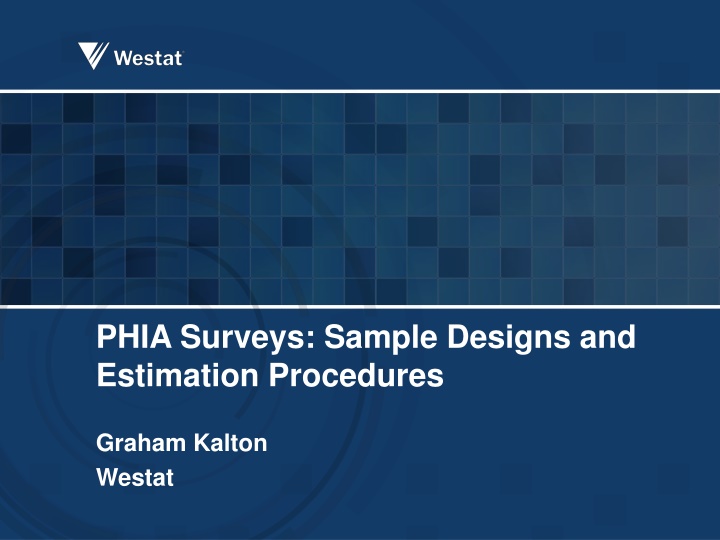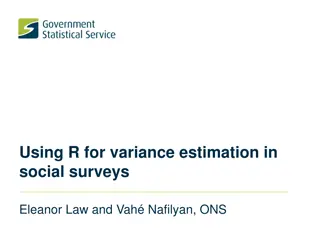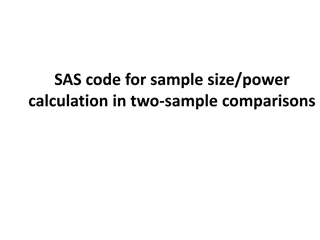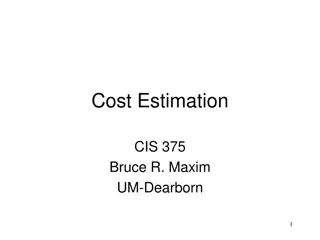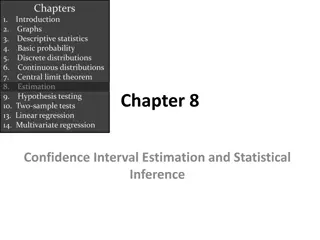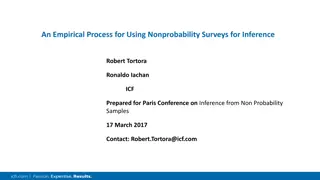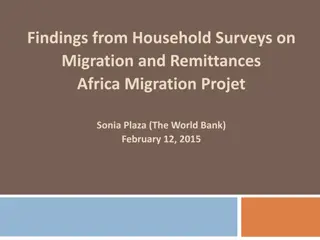PHIA Surveys: Overview of Sample Designs and Estimation Procedures
This presentation covers the nationally representative three-stage sample design of PHIA surveys, focusing on the sampling of Census Enumeration Areas (EAs), households, and persons. It discusses the importance of weighting to account for selection probabilities, nonresponse, and noncoverage, as well as the key estimates required, such as HIV incidence rates and viral load suppression. The sampling process, including stratified probability proportional to size (PPS) design for EAs and household selection, is detailed, emphasizing the challenges posed by outdated census counts.
Download Presentation

Please find below an Image/Link to download the presentation.
The content on the website is provided AS IS for your information and personal use only. It may not be sold, licensed, or shared on other websites without obtaining consent from the author.If you encounter any issues during the download, it is possible that the publisher has removed the file from their server.
You are allowed to download the files provided on this website for personal or commercial use, subject to the condition that they are used lawfully. All files are the property of their respective owners.
The content on the website is provided AS IS for your information and personal use only. It may not be sold, licensed, or shared on other websites without obtaining consent from the author.
E N D
Presentation Transcript
PHIA Surveys: Sample Designs and Estimation Procedures Graham Kalton Westat
PHIA sampling workshops This presentation provides a broad overview of the PHIA sampling and weighting issues. The next two sampling workshop will go through components of these issues in greater detail: The next sampling workshop will focus on design issues The following workshop will focus on weighting and variance estimation 2
Overview Nationally representative three-stage sample design: First stage: Census Enumeration Areas (EAs). Second stage: Households Third stage: Persons Weights adjust for unequal selection probabilities, nonresponse, and noncoverage Weights need to be used in analyzing PHIA surveys to produce valid estimates Standard errors of the survey estimates need to take account of the complex sample design and weighting. 3
Key estimates required from PHIA surveys The sample designs are constructed to provide specified precision levels for 15-49 year olds: National HIV incidence rates Regional/provincial estimates of viral load suppression (VLS) A secondary aim is to provide a specified precision level for an estimate of pediatric HIV prevalence Since these objectives generally lead to different sample allocations across regions/provinces, a nonlinear programming procedure is used to produce the smallest overall sample size that satisfies both precision requirements. 4
Sampling the EAs A stratified probability proportional to size (PPS) sample design Stratification Primary stratification by region/province Within region/province, proportionate stratification by geographical location, urban/rural Equal selection probabilities within regions PPS sampling PPS measure of size: household count from the last Population Census Problems arise when out-of-date Census counts are poor estimates of the current household counts. 5
Sampling households in selected EAs Listers construct lists of all households in each of the selected EAs A systematic sample of households is selected from the list, using a pre-specified sampling fraction. The overall selection probability is constant (? = ?/?) within a region ? ?? = ? ? ?(? ? = ? ? ? = ?? / ?? where ??is the Census household count Hence the within-EA sampling fraction for selecting households is ?/?(?) 6
Household sampling With the equal probability sample design for a region, ?) ?? ??? ? = (? ? ? ? = ? ? With ? = ?? ,? ? ? = ?/??, where ? = ??. Applying the sampling fraction ?/?? to the ?? listed households yields a sample of ???/?? households. If ??= ??, the sample size will be ? households. If ?? and ?? differ markedly, the sample size will deviate from ?. PHIA lets the sample size vary within limits, unlike DHS which takes a fixed sample size of ?. 7
Person sampling Construct a household roster and take all eligible persons in selected households. De facto population, those sleeping in the household the previous night Up age limit varies: no limit, 60 and over, 65 and over Guardians provide the data for children aged 0-14 Data for all others are collected by personal interviews In some countries, children 0-14 years of age are subsampled with data collected for them in one-half or one-third of the households. 8
Weighting Weighting has three purposes: To compensate for unequal selection probabilities, particularly across regions To compensate for nonresponse To the household questionnaire Person nonresponse within responding households Nonresponse to the blood draw among interview respondents To compensate for noncoverage Incomplete household listings Failure to include all eligible persons on the roster. 9
Weights for unequal selection probabilities The probability of selecting a household for a PHIA survey is ? ?? = ? ? ?(? ? . The sample base weight is then [?/?(??)] The same base weight applies to persons within the household since all eligible persons are selected. A household with a base weight of 100 represents 100 households in the population, whereas one with a base weight of 200 represents 200 households. With no nonresponse or noncoverage, a weighted analysis of the sample data expands the sample up to be a representation of the full population. 10
Nonresponse adjustments The aim is to increase the weights of the eligible respondents so that they also represent eligible nonrespondents. For household level nonresponse, the only information available for the nonrespondents is their EA. Compensation for household nonresponse is therefore being made by inflating the weights of the responding households in an EA so that they represent the nonresponding households in that EA. 11
Person level nonresponse adjustments In addition to EA, a great deal of information about nonresponding persons is available from the household questionnaire. The nonresponse weighting cells are being obtained from a CHAID analysis (using SI-CHAID) that uses response status as the dependent variable. Within each cell, the weights of the respondents are increased so that they also represent the nonrespondents. For the blood collection nonresponse, the same approach is being used, but now also including information from the interview 12
CHAID tree Ages 15 and older RR = 92% 20,000 Sex Male Female RR = 94% 11,000 RR = 87% 9,000 Relationship to head of household Number in household 3-5 1,2 6+ RR = 87% 4,250 RR = 85% 3,325 RR = 95% 1,275 Household power source Final Cell Household owns transportation? Extended family, other Bike or Motorcycle None Solar or battery Electricity Immediate family Car or none RR = 90% 2,250 RR = 89% 2,025 RR = 82% 625 RR = 73% 675 RR = 92% 675 RR = 96% 8,750 RR = 98% 600 Any deaths in household since 2013? Final cell Final Cell Final cell Final cell Age category Final Cell 30+ 18-29 15-17 Yes No RR = 95% 350 RR = 97% 5,650 RR = 95% 2,450 RR = 90% 650 RR = 89% 1,900 Final cell Final cell Final cell Final cell Final cell 13
Noncoverage adjustment The nonresponse adjusted weights should represent the full population of those who had a chance of selection for the sample. These weights are then further adjusted to make the final weights conform to known population counts. A source for the population counts is the population projections for the survey year, say by age/sex and perhaps within region. 14
Analyzing PHIA surveys The analyses need to conducted using the final weights in order that the survey estimates represent the full population. The sampling errors of the estimates should be estimated with a method that takes account of the complex sample design and the weights The methods supported by the PHIA data files are: The Taylor series (linearization) method The jackknife repeated replications (JRR) method This method repeatedly drops out some observations from the full sample, and reweights the remaining sample in compensation. 15
